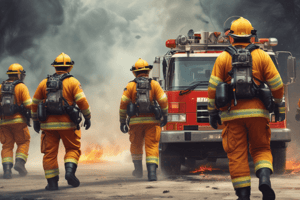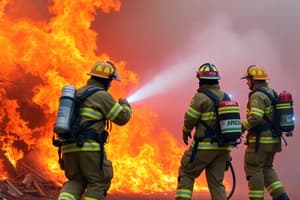Podcast
Questions and Answers
What was one of the outcomes of the training exercises conducted after Bret Tarver's death?
What was one of the outcomes of the training exercises conducted after Bret Tarver's death?
- Firefighters were required to exit immediately upon hearing the low air alarm.
- Firefighters learned they can travel less than 150 feet until air supply is exhausted. (correct)
- Firefighters no longer needed to monitor air supply during operations.
- Firefighters were advised to increase their air supply before entering buildings.
What risk is associated with the approach of working until the low air alarm activates in commercial occupancies?
What risk is associated with the approach of working until the low air alarm activates in commercial occupancies?
- High likelihood of running out of air supply and facing life-threatening situations. (correct)
- Increased chance of dehydration and fatigue.
- Minimal ventilation leading to excessive heat buildup.
- Greater chances of structural collapse during firefighting operations.
What was a significant finding from the incidents involving air supply emergencies in the Phoenix Regional Dispatch System?
What was a significant finding from the incidents involving air supply emergencies in the Phoenix Regional Dispatch System?
- All air supply emergencies resulted in fatalities.
- Emergency situations often left firefighters with a reduced chance of survival. (correct)
- Air management protocols were deemed unnecessary.
- Firefighters consistently managed to handle air supply efficiently.
How does the size and structure of typical residential fires differ from that of commercial occupancies according to the Phoenix Regional Dispatch System's historical response?
How does the size and structure of typical residential fires differ from that of commercial occupancies according to the Phoenix Regional Dispatch System's historical response?
What emergency situations can significantly reduce a firefighter's chance of survival when air supply is low?
What emergency situations can significantly reduce a firefighter's chance of survival when air supply is low?
Flashcards are hidden until you start studying
Study Notes
Historical Context of Phoenix Firefighting
- Most fires responded to by the Phoenix Regional Dispatch System involve single and multiple family residences.
- Residential fires are generally smaller and provide easier access to the exterior for firefighting efforts.
Air Supply Management Challenges
- Traditional firefighting practices often neglect air supply management due to emphasis on residential structures.
- Life-threatening outcomes arise when applying standard practices to commercial fire situations.
Incidents and Interventions
- Phoenix Regional Dispatch System has experienced numerous air supply emergencies during fire responses.
- Most incidents were resolved successfully despite not altering the overall approach to air management.
Training and Investigation Post-Incident
- Bret Tarver's death at the Southwest Supermarket fire in 2001 prompted extensive training evaluations by the Phoenix Fire Department.
- Training exercises aimed to identify causes and devise solutions for life-threatening emergencies during commercial fires.
Findings on Air Supply Limitations
- Research indicated that upon low air alarm activation, firefighters can travel less than 150 feet in favorable conditions before air supply is depleted.
- Emergencies during this timeframe (e.g., losing the hose line, entanglement, disorientation) significantly decrease survival chances.
Studying That Suits You
Use AI to generate personalized quizzes and flashcards to suit your learning preferences.




